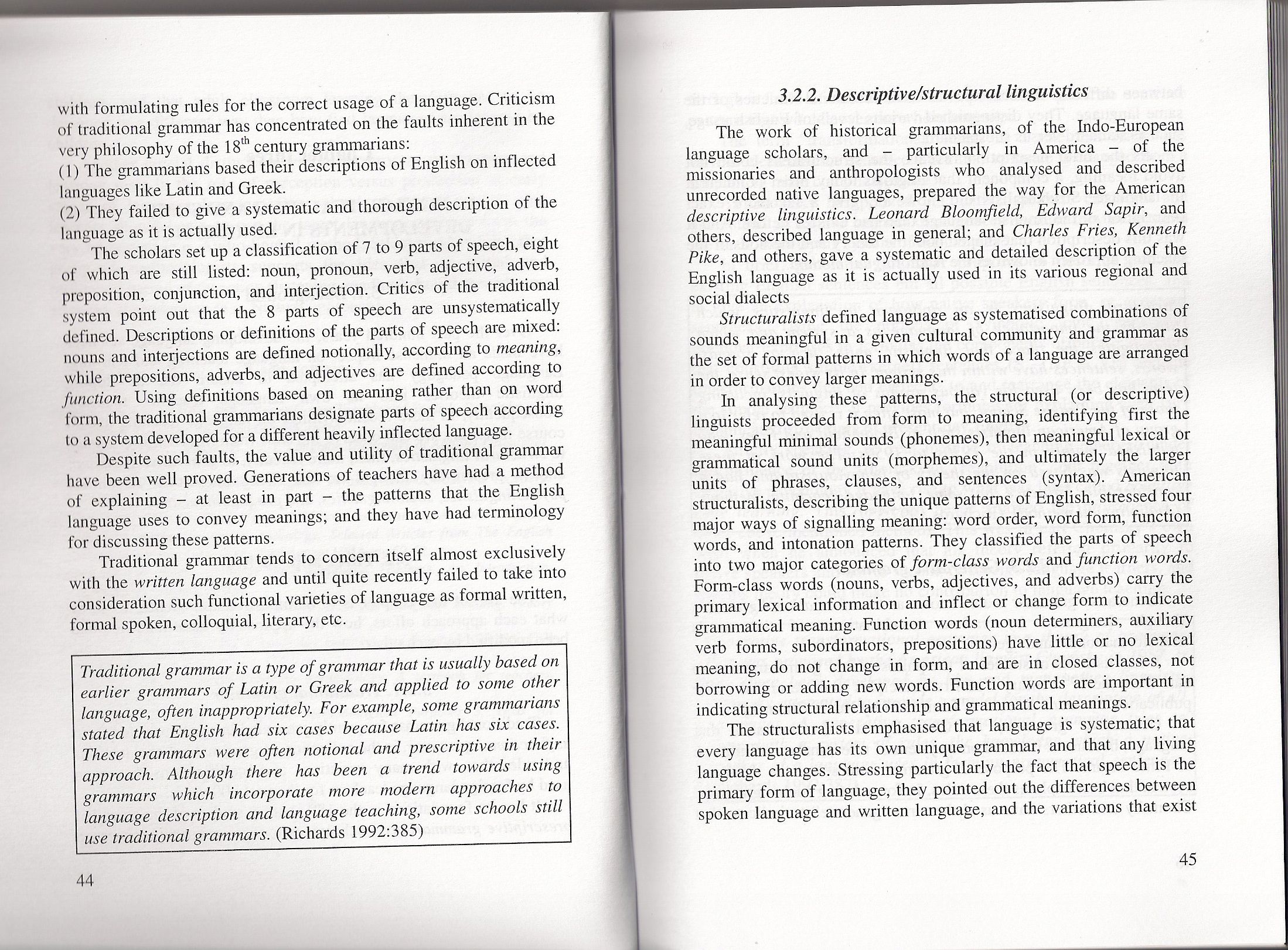38973 skanowanie0022 (23)

with formulating rules for the correct usage of a language. Criticism of traditional grammar has concentrated on the faults inherent in the very philosophy of the 18* century grammarians:
(1) The grammarians based their descriptions of English on inflected languages like Latin and Greek.
(2) They failed to give a systematic and thorough description of the language as it is actually used.
The scholars set up a classification of 7 to 9 parts of speech, eight of which are still listed: noun, pronoun, verb, adjective, adverb, preposition, conjunction, and interjection. Critics of the traditional system point out that the 8 parts of speech are unsystematically defined. Descriptions or definitions of the parts of speech are mixed: nouns and interjections are defined notionally, according to meaning, while prepositions, adverbs, and adjectives are defined according to function. Using definitions based on meaning rather than on word form, the traditional grammarians designate parts of speech according to a system developed for a different heavily inflected language.
Despite such faults, the value and utility of traditional grammar have been well proved. Generations of teachers have had a method of explaining - at least in part - the pattems that the English language uses to eonvey meanings; and they have had terminology for discussing these pattems.
Traditional grammar tends to concern itself almost exclusively with the written language and until quite recently failed to take into consideration such functional varieties of language as formal written, formal spoken, colloąuial, literary, etc.
Traditional grammar is a type of grammar that is usually based on earlier grammars of Latin or Greek and applied to some other language, often inappropriately. For example, some grammarians stated that English had six cases because Latin has six cases. These grammars were often notional and prescriptive in their approach. Although there has been a trend towards using grammars which incorporate morę modem approaches to language description and language teaching, some schools still use traditional grammars. (Richards 1992:385)
3.2.2. Descriptive/structural linguistics
The work of historical grammarians, of the Indo-European language scholars, and particularly in America - of the missionaries and anthropologists who analysed and described unrecorded native languages, prepared the way for the American descriptive linguistics. Leonard Bloomfield, Edward Sapir, and others, described language in generał; and Charles Fries, Kenneth Pikę, and others, gave a systematic and detailed description of the English language as it is actually used in its various regional and social dialects
Structuralists defined language as systematised combinations of sounds meaningful in a given cultural community and grammar as the set of formal pattems in which words of a language are arranged in order to convey larger meanings.
In analysing these pattems, the structural (or descriptive) linguists proceeded from form to meaning, identifying first the meaningful minimal sounds (phonemes), then meaningful lexical or grammatical sound units (morphemes), and ultimately the larger units of phrases, clauses, and sentences (syntax). American structuralists, describing the uniąue pattems of English, stressed four major ways of signalling meaning: word order, word form, function words, and intonation pattems. They classified the parts of speech into two major categories of form-class words and function words. Form-class words (nouns, verbs, adjectives, and adverbs) carry the primary lexical information and inflect or change form to indicate grammatical meaning. Function words (noun determiners, auxiliary verb forms, subordinators, prepositions) have little or no lexical meaning, do not change in form, and are in closed classes, not borrowing or adding new words. Function words are important in indicating structural relationship and grammatical meanings.
The structuralists emphasised that language is systematic; that every language has its own uniąue grammar, and that any living language changes. Stressing particularly the fact that speech is the primary form of language, they pointed out the differences between spoken language and written language, and the variations that exist
45
Wyszukiwarka
Podobne podstrony:
help 11 CSS StyleS Ac*d, overwrite css rules for the chosen template with your own.
1) staffing with ąualifications suitable for the courses offered, 2)
Introduction1 INTRODUCTION1.1 BACKGROUND OF THE STRATEGY, DEVELOPMENT RULES FOR THE DOCUMENT The wor
CQS04 4r (b) Torches with clip attachments for the weapons concemed: the beam of t
How to Order □1 OE 03 IW □5 AddTo Pay with Dispatch Sign For The Confirm
Rules Teacher Student Contract Rules For the Students: (1) Students will listen wh
Eyelet Template (23) squares. Mark holes for the eyelets. Cut the lines of the four squares to make
al creatures 36 Start with basie shapes for the main parts of the wizard s body and lines for h
23 (884) 2.2.3B. Therapy for the pectoralis major, clavicular part. Unilateral stretching. Starting
skanowanie0030 (15) Students who have had to accomplish a rangę of tasks and activities centred on a
00208 ?1906ab0bcf2542dac76203983810dc 210 Messina, Montgomery, Keats & Runger Table 4. Average
img028 (28) The ADOBE TABLE RUNNER combines subtle, organie geometrie texture with linen’s shee
skanuj0059 (23) 180 MARTA DEREK objectives of the economic development of the commune. For example,
mathematical to some cxtcnt but in most instances the formulas have beon workcd out for the stu
więcej podobnych podstron